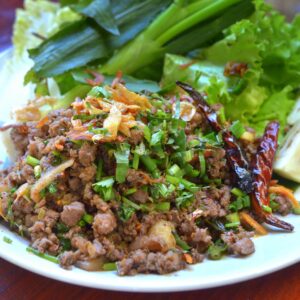It’s remote, tropical, and produces one of the best beers in the world! South-East Asia’s only landlocked nation boasts 4,000 islands, where the Mekong River breaks into hundreds of waterways. Only three are inhabited, but all are stunning – a mixture of pristine sandbanks and palmy paradise thanks to the region’s tropical climate.
The rewards for visitors are great – especially gastronomically speaking. The Laotians are the highest consumers of sticky rice in the world, and actually refer to themselves as luk khao niao, or ‘children of sticky rice’. It’s a food that pops up at every meal, often with larb or tam mak hoong…

The second is another salad, a local variation on the Thai som tam. Known locally as tam mak hoong, it’s made with slivers of unripe green papaya, tomatoes, salt, sugar, chilli and limes. Pounded garlic is often liberally added, along with peanuts, cabbage, and pah deck (a pungent fish paste that’s a national favourite), and it’s all served up with either rice noodles or sticky rice.
Certainly a country of salty tastes, Laos likes to wash down its savoury cuisine with either coffee or beer. Laotian coffee (kaa-feh Lao) is, in fact, the country’s biggest export. And the beer has to be Beerlao – an award-wining brand that’s part-owned by Carlsberg and offers a range of lagers. Made with local jasmine rice, this beer enjoys a 99 per cent local market share, so you’re going to find it absolutely everywhere. Even on the most remote of islands!







Click here to change your cookie preferences